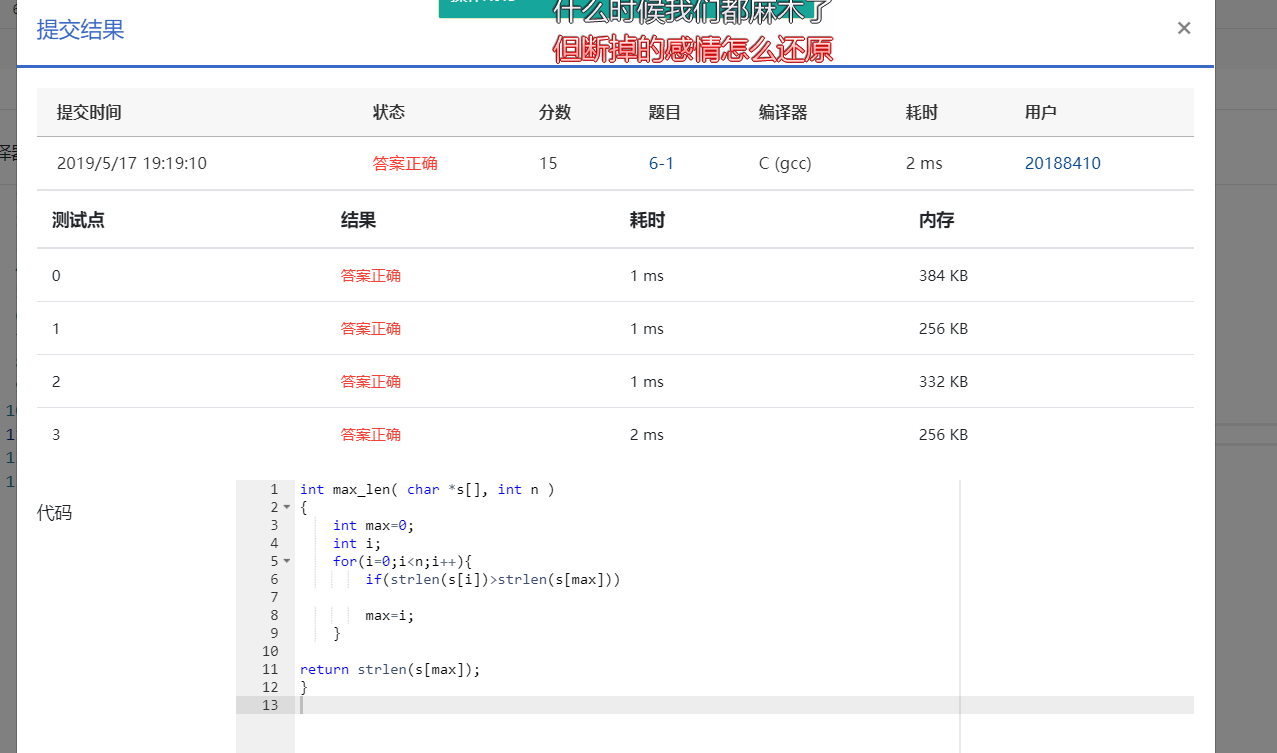| 这个作业属于哪个课程 | C语言程序设计II |
| 这个作业要求在哪里 | 掌握(1)二级指针的概念,以及指针数组的应用;(2)了解指针与函数的关系,掌握指针作为函数返回值;(3)掌握单向链表的概念和操作(建立、增加、删除、修改、遍历) |
| 我在这个课程的目标是 | 我希望能够通过学习C语言的知识,编写程序 |
| 这个作业在哪个具体方面帮助我实现目标 | 数组指针,指针函数,函数指针,指针数组 |
| 参考文献 | https://www.runoob.com/cprogramming/c-arrays.html |
6-1 计算最长的字符串长度 (15 分)
本题要求实现一个函数,用于计算有n个元素的指针数组s中最长的字符串的长度。
函数接口定义:
int max_len( char *s[], int n );
其中n个字符串存储在s[]中,函数max_len应返回其中最长字符串的长度。
裁判测试程序样例:
#include <stdio.h>
#include <string.h>
#include <stdlib.h>
#define MAXN 10
#define MAXS 20
int max_len( char *s[], int n );
int main()
{
int i, n;
char *string[MAXN] = {NULL};
scanf("%d", &n);
for(i = 0; i < n; i++) {
string[i] = (char *)malloc(sizeof(char)*MAXS);
scanf("%s", string[i]);
}
printf("%d
", max_len(string, n));
return 0;
}
/* 你的代码将被嵌在这里 */
输入样例:
4
blue
yellow
red
green
输出样例:
6
代码:
int max_len( char *s[], int n )
{
int max=0;
int i;
for(i=0;i<n;i++){
if(strlen(s[i])>strlen(s[max]))
max=i;
}
return strlen(s[max]);
}

之前错误原因就是把函数名len打成了strlen
思路:就是用for循环来判断最大长度,如果指针数组第i项长度大于之前最大长度max,就继续吧i赋值给max。
6-2 统计专业人数 (15 分)
本题要求实现一个函数,统计学生学号链表中专业为计算机的学生人数。链表结点定义如下:
struct ListNode {
char code[8];
struct ListNode *next;
};
这里学生的学号共7位数字,其中第2、3位是专业编号。计算机专业的编号为02。
函数接口定义:
int countcs( struct ListNode *head );
其中head是用户传入的学生学号链表的头指针;函数countcs统计并返回head链表中专业为计算机的学生人数。
裁判测试程序样例:
#include <stdio.h>
#include <stdlib.h>
#include <string.h>
struct ListNode {
char code[8];
struct ListNode *next;
};
struct ListNode *createlist(); /*裁判实现,细节不表*/
int countcs( struct ListNode *head );
int main()
{
struct ListNode *head;
head = createlist();
printf("%d
", countcs(head));
return 0;
}
/* 你的代码将被嵌在这里 */
输入样例:
1021202
2022310
8102134
1030912
3110203
4021205
输出样例:
3
代码:
int countcs(struct ListNode *head)
{
int count=0;
for(int i=0;head!=NULL;i++)
{
if((*head).code[1]=='0'&&(*head).code[2]=='2')
count++;
head=head->next;
}
return count;
}

这里需要注意的就是结构体格式不要忘记了还有字符符号‘’
6-3 删除单链表偶数节点 (20 分)
本题要求实现两个函数,分别将读入的数据存储为单链表、将链表中偶数值的结点删除。链表结点定义如下:
struct ListNode {
int data;
struct ListNode *next;
};
函数接口定义:
struct ListNode createlist();
struct ListNode deleteeven( struct ListNode *head );
函数createlist从标准输入读入一系列正整数,按照读入顺序建立单链表。当读到−1时表示输入结束,函数应返回指向单链表头结点的指针。
函数deleteeven将单链表head中偶数值的结点删除,返回结果链表的头指针。
裁判测试程序样例:
#include <stdio.h>
#include <stdlib.h>
struct ListNode {
int data;
struct ListNode *next;
};
struct ListNode *createlist();
struct ListNode *deleteeven( struct ListNode *head );
void printlist( struct ListNode *head )
{
struct ListNode *p = head;
while (p) {
printf("%d ", p->data);
p = p->next;
}
printf("
");
}
int main()
{
struct ListNode *head;
head = createlist();
head = deleteeven(head);
printlist(head);
return 0;
}
/* 你的代码将被嵌在这里 */
输入样例:
1 2 2 3 4 5 6 7 -1
输出样例:
1 3 5 7
代码:
struct ListNode *createlist(){
struct ListNode * p ,*tail,*head=NULL;
int size = sizeof (struct ListNode);
int n,i;
scanf("%d",&n);
for (i=0;n!=-1;i++)
{
p=(struct ListNode *) malloc(size);
p->data = n;
if(head==NULL){
head=p;
tail=p;
}
else {
tail->next = p;
}
tail = p;
scanf("%d",&n);
}
p->next=NULL;
return head;
}
struct ListNode *deleteeven( struct ListNode *head )
{
struct ListNode *p,*part1,*part2;
while(head && head->data %2 ==0){
part1=head;
head = head->next;
free(part1);
}
part1=head;
while(part1 && part1 ->next !=NULL)
{
while(part1->next && part1->next->data%2==0)
{
part2=part1->next;
part1->next=part2->next;
}
part1=part1->next;
}
return head;
}
参考链接:
https://blog.csdn.net/weixin_44061561/article/details/85732857
head && head->data%2==0 //保证头结点不是偶数
p = head;
head = head->next;
free(p); //head空指针或者指向一个奇数节点,外层循环判断到结尾,内层循环连续删除
